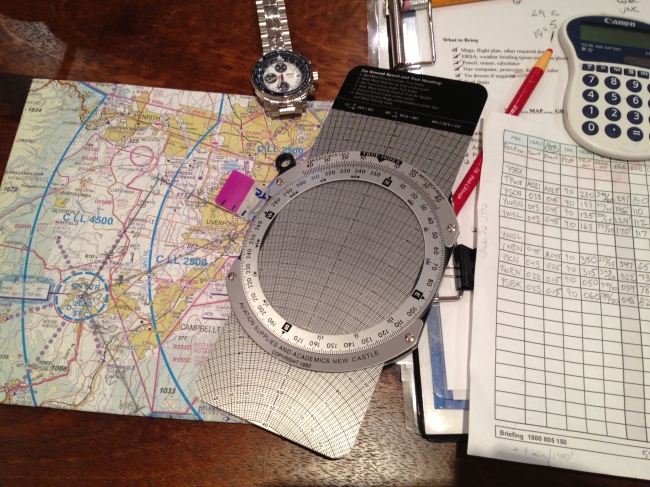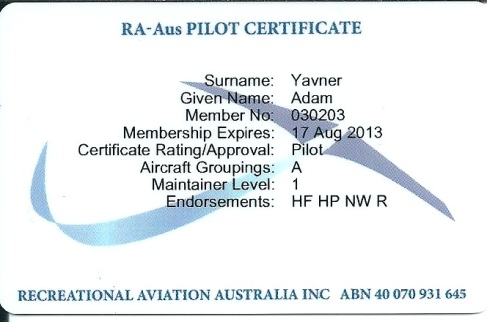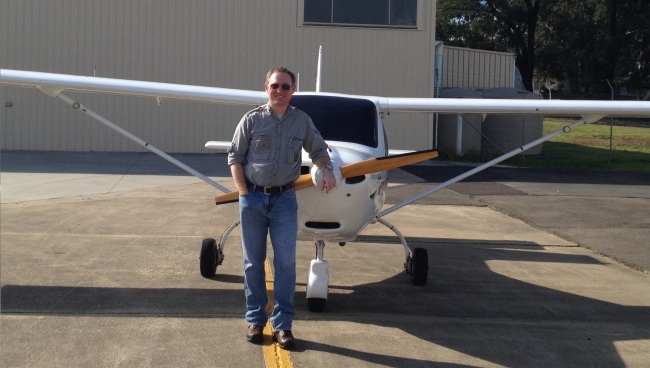This weekend, I took my first navigation lesson. I had actually taken the 4 hours of briefings back in January in anticipation that I’d be doing those at the time. The plan was to do those flights and work the required solo time into them so that I could end up with my Cross Country and Passenger endorsements at the same time as achieving the certificate. But after about 4 rained out attempts, I switched gears and went somewhere else to do my solos (thanks Bruce!) and recently wrapped up my certificate (thanks Brett!).
Now that the weather is starting to get good, it was high time to put all that knowledge into practical use. Up to this point, flying has been all about doing laps around the aerodrome, or practicing maneuvers in the nearby training area. So now, I am learning and practicing what it takes to get from one aerodrome to another using only a map, watch and compass. Sure, GPS is available and can be used as a secondary source of information, but it is so important to know how to navigate by reference to the map and ground features – what happens if the battery dies or the GPS satellites go out??
The first exercise was to get from Bankstown to Wollongong and back. This first exercise is to put into practice the concepts learned in the breifing.
I would estimate 90% of this is in preparation. Well before the flight, you need to ensure a current copy of all necessary charts. Plot a course from point A to point B – but this won’t necessarily be in a straight line! You have to make sure you are clear of controlled airspace or restricted areas as well as making sure you select an altitude that will be well clear of any obstacles or terrain, but that is not too high for the airspace you are in (as depicted on the chart). For this exercise, we chose to fly at 4,500 ft.
Continuing the preparation, you have to measure the direction of each track in degrees as well as the distance for each segment. You pick a speed for the aeroplane to fly, we selected 90 knots.
Now True North (as depicted on the chart) is different from Magnetic North (as read by the compass). There is a variation that is different depending on where in the world you are – its -11 degrees for me here. so without getting into too much technical detail, all directions in the plan have to be converted to degrees magnetic so you can read directly from the compass in the aeroplane without having to think about it.
On the day, you get a weather report – not just any weather report, but the one for your specific area as provided by http://www.airservicesaustralia.com. This gives aviation-specific weather reporting and forecasts for the area and aerodromes, as well as any important items to be aware of – Notices to Airmen (NOTAMS). These are important – for example, one NOTAM stated that the automated weather service for Wollongong was not available. So knowing this, I can plan not to try to get it over the radio but instead plan to fly over the airfield at 1500′ to determine the wind direction.
With the weather report, you also get information regarding cloud cover, atmospheric pressure (QNH), turbulence in the area, and winds at various heights. This is important, because in the flight plan you need to account for the wind direction and strength. You may need to fly to a point East, but if the wind is blowing strongly from the North, then your heading will actually be somewhat into the wind to compensate for this. Where the aeroplane is pointing and where it is going are often two different things. Similarly, the amount of ground you cover in a given time might not be the same as the speed you think you are going. I might be indicating 90 knots of airspeed, but if I am heading into a 10 knot headwind, then my track over the ground is actually 80 knots. That is important because speed and distance are used to calculate time.
Time is calculated for each segment of the trip. This is important because you are following a track on your map and you need to have an idea of what landmarks you will expect to see at a given time. For example, if I’ve calculated it should take me 15 minutes to reach Camden, I should also be able, at 5 minutes, to start seeing landmarks that are roughly a 3rd of the way there.
It’s all very complex (to me at least) so I won’t go on about it. Here is a snapshot of some of the tools used:
Sunday morning was perfect, so I got to the school about an hour early, spread out my gear, got the weather report and finished filling in my flight plan. The flight plan is the result of all the planning – it is like an itinerary, and tells you exactly which direction to travel, for how long, at what speed, and when to turn. Sticking to the plan is fairly straight forward – occasionally note the time, figure out where on the map you should be (based on the plan), then look at the ground to verify or adjust. If you are off or a little fast or slow, you can make a correction to the estimate as the winds are seldom exactly as stated in the report. Brett did ask me when I got the winds, and I said “pretty much right after lunch”. Not sure if he got it or not.
The plan took us to a point (small lake) 11 miles to the West of Bankstown at 2,500 ft. After that, a turn to the South for Camden and a climb to 4,500 feet. Any time we approach an aerodrome or airfield, I’d make a radio call just to let them know I am in the area – common courtesy. Overhead Camden, I turned to the South East to fly over Wedderburn before finally turning more or less South towards Wollongong. since the NOTAM advised that the automated weather service was out, I descended to 1,500 feet and flew overhead to have a look at the windsock before letting down to 1,000 ft to join the circuit for runway 34. We did two circuits and an overhead departure back the way we came.
I was pleased that my planning was pretty solid because we made it overhead Wollongong within 1 minute of my plan. On the way back, I think the winds died down a bit so as a consequence I managed a much faster groundspeed than planned for and reached Bankstown about 5 minutes early. In subsequent lessons, I’ll learn how to refine that ‘on the fly’ so to speak, but I was pretty happy with this first one.
Upcoming lessons will cover diversions (in case the destination can’t be reached due to weather, low fuel, zombie attack), lost procedures, and low-level navigation. After all that time running uphill to get my certificate, it is amazing to think that I am just a few more lessons away from being able to go cross country! I am hoping to have that and the passenger endorsement wrapped up by the end of the year, but for now I have a little over a month to absorb what I learned on this trip – what worked out, what didn’t, and what adjustments I need to make.
Next time I will be sure to take some great pics!


